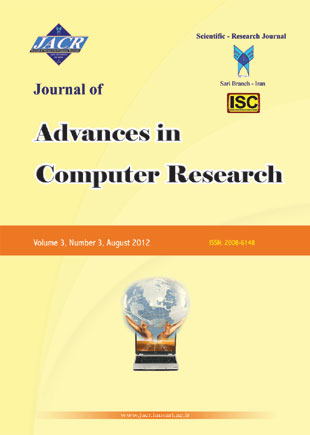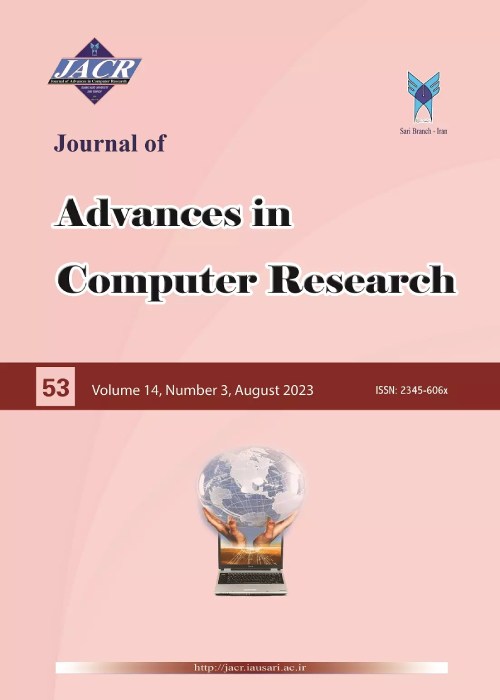فهرست مطالب

Journal of Advances in Computer Research
Volume:3 Issue: 3, Summer 2012
- تاریخ انتشار: 1391/11/25
- تعداد عناوین: 8
-
Page 1Information retrieval can be achieved through computerized processes by generating a list of relevant responses to a query. The document processor, matching function and query analyzer are the main components of an information retrieval system. Document retrieval system is fundamentally based on: Boolean, vector-space, probabilistic, and language models. In this paper, a new methodology for matching function of Boolean retrieval systems is proposed and tried to extend postings list data structures and increase the efficiency of using postings lists and skips. The final effect of these considerations is in decreasing the search time.Keywords: Information retrieval, Boolean retrieval, Inverted index, skip pointer
-
Page 9Permanent magnet synchronous motors are efficient motors, which have widespread applications in electric industry due to their noticeable features. One of the interesting applications of such motors is in underwater vehicles. In these cases, reaching to minimum volume and high torque of the motor are the major concern. Design optimization can enhance their merits considerably, thus reduce volume and improve performance of motors. In this paper, a new method for optimum design of a five-phase surface-mounted permanent magnet synchronous motor is presented to achieve minimum loss and magnet volume with an increased torque. A multi-objective optimization is performed in search for optimum dimensions of the motor and its permanent magnets using particle swarm optimization. The design optimization results in a motor with great improvement regarding the original motor.Keywords: Permanent magnet, Particle swarm optimization, Finite element analysis, Underwater vehicles
-
Page 19The IP Lookup Process is a key bottleneck in routing due to the increase in routing table size, increasing traffic and migration to IPv6 addresses. The IP address lookup involves computation of the Longest Prefix Matching (LPM), which existing solutions such as BSD Radix Tries, scale poorly when traffic in the router increases or when employed for IPv6 address lookups. In this paper, we describe a high performance parallel IP lookup mechanism based on distributed memory organization that uses P processor for solving LPM problem. Since multiple processors are used, the number of prefixes to be compared for each processor has been reduced. In other words each processor needs to find LPM for a specific IP address among N/P of prefixes. In order to reduce the number of memory access in each processor which is a major bottleneck in IP lookup process, we use ISCB-Tree data structure for the sake of storing the forwarding table in each processor. ISCB-Tree is a B-Tree like data structure that reduces the height of prefix tree and logarithmic growing manner with the increasing number of prefixes. By the using of this data structure the number of memory access reduces sharply.Keywords: IP lookup, Packet forwarding, ISCB, Tree, Router organization, Parallel processing
-
Page 35The aim of this study is to show that the measures derived from Electrocardiogram (ECG) signals many a time perform better than the same measures obtained from heart rate (HR) signals. A comparison was made to investigate how far the nonlinear symbolic dynamics approach helps to characterize the nonlinear properties of ECG signals and HR signals, and thereby discriminate between normal and congestive heart failure (CHF) subjects. The symbolic dynamics calculations performed on normal and CHF ECG and HR signals showed significant differences in the symbol-sequence histogram statistics and complexity measures (modified Shannon entropy (MSE) and multi-valued Lempel-Ziv complexity (MLZC)) of symbol sequences between the two groups. The ability of these complexity measures to discriminate normal from CHF subjects was evaluated using receiver operating characteristic (ROC) plots. It is found that MSE and MLZC measures obtained from ECG signals performed better than the same measures derived from HR signals of the same subjects.Keywords: Congestive heart failure, Complexity measures, Electrocardiogram signal, Heart rate signal, Modified Shannon entropy, Multi, valued Lempel, Ziv complexity, Symbolic dynamics
-
Page 53There are many methods introduced to solve the credit scoring problem such as support vector machines, neural networks and rule based classifiers. Rule bases are more favourite in credit decision making because of their ability to explicitly distinguish between good and bad applicants.In this paper multi-objective particle swarm is applied to optimize fuzzy apriori rule base in credit scoring. Different support and confidence parameters generate different rule bases in apriori. Therefore Multi-objective particle swarm is used as a bio-inspired technique to search and find fuzzy support and confidence parameters, which gives the optimum rules in terms of maximum accuracy, minimum number of rules and minimum average length of rule. Australian, Germany UCI and a real Iranian commercial bank datasets is used to run the algorithm. The proposed method has shown better results compared to other classifiers.Keywords: Credit scoring, Banking, Fuzzy association rules, Apriori, multi, objective particle swarm
-
Page 65In this paper, a new method was proposed for the navigation of a mobile robot in an unknown dynamic environment. The robot could detect only a limited radius of its surrounding with its sensors and it went on the shortest null space (SNS) toward the goal. In the case of no obstacle, SNS was a direct path from the robot to goal; however, in the presence of obstacles, SNS was a space around the robot where fewer or no obstacles existed. In every time step, the robot went to null space. The simulation of robot navigation by SNS method showed that SNS can be a simple and very robust method.Keywords: Shortest null space, Navigation, Mobile robot, Unknown environment
-
Page 75The traveling salesman problem (TSP) is the problem of finding the shortest tour through all the nodes that a salesman has to visit. The TSP is probably the most famous and extensively studied problem in the field of combinatorial optimization. Because this problem is an NP-hard problem, practical large-scale instances cannot be solved by exact algorithms within acceptable computational times. So, an efficient hybrid metaheuristic algorithm called ICATS is proposed in this paper. The first stage of the ICATS is to solve the TSP by the imperialist competitive algorithm (ICA), and then the TS is used for improving solutions. This process avoids the premature convergence and makes better solutions. Computational results on several standard instances of TSP show efficiency of the proposed algorithm compared with the genetic algorithm (GA), bee colony optimization (BCO), and particle swarm optimization (PSO).Keywords: Tabu search, Imperialist competitive algorithm, Traveling salesman problem, NP, hard problems
-
Page 85Various synthesis methods have been proposed in the literature for reversible and quantum logic circuits. However, there are few algorithms to optimize an existing circuit with multiple constraints simultaneously. In this paper, some heuristics in genetic algorithms (GA) to optimize a given circuit in terms of quantum cost, number of gates, location of garbage outputs, and delay, are proposed. The proposed methods can optimize an existing circuit with a given truth table, including don’t care values, for different aspects of optimality. The results show good enhancements in the optimization of benchmark circuits compared to the previously published methods.Keywords: Optimization, Genetic algorithms, Reversible logic, Quantum circuit, Heuristic method


